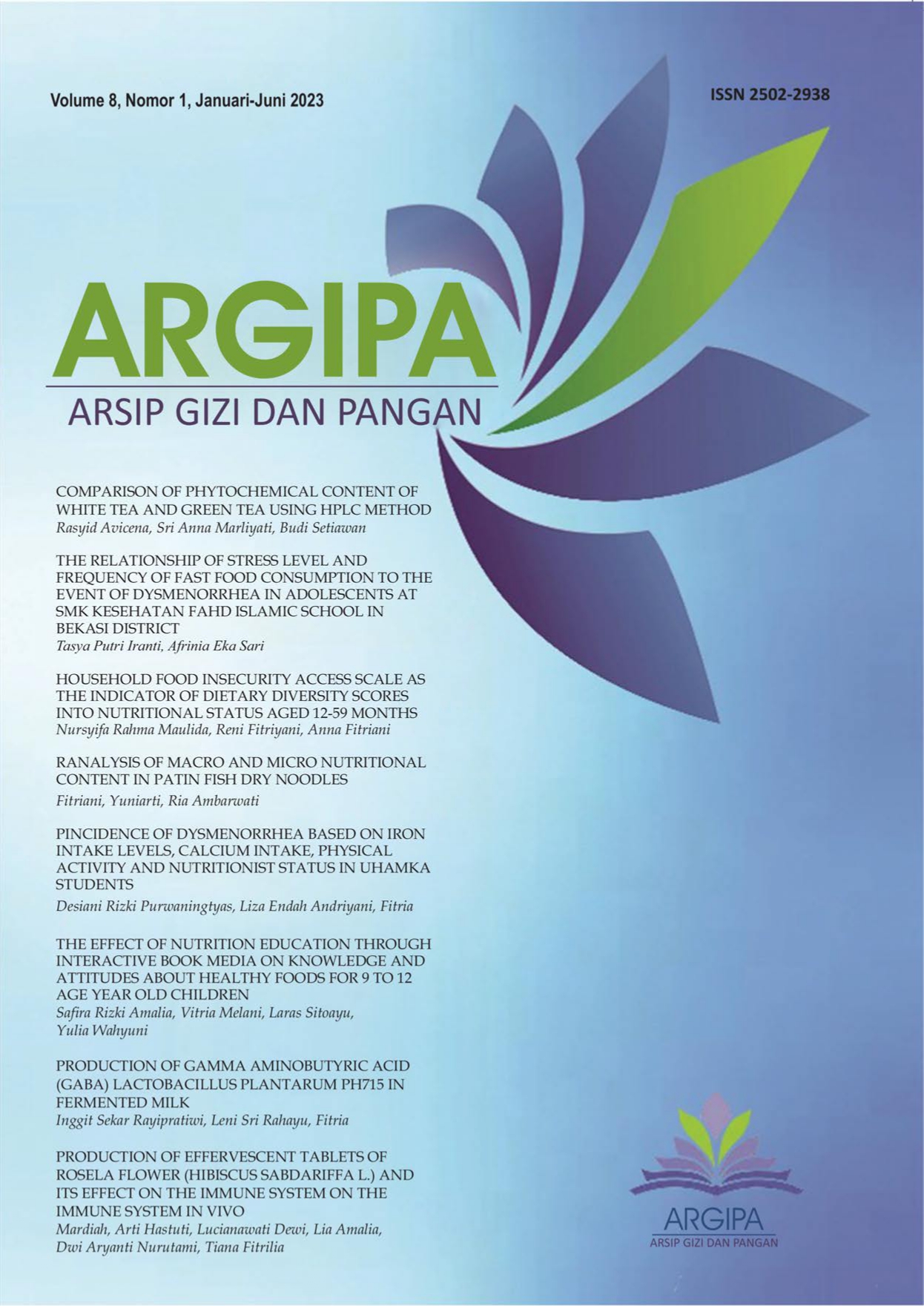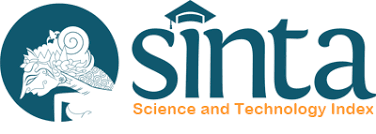The relationship of stress level and frequency of fast food consumption to the event of dysmenorrhea in adolescents at SMK Kesehatan Fahd Islamic School in Bekasi District
DOI:
https://doi.org/10.22236/argipa.v8i1.10624Keywords:
fast-food consumption, incidence of dysmenorrhea, stress levelAbstract
The women who have experienced menstruation, there is a chance of dysmenorrhea. Dysmenorrhea tends to occur more frequently and more intensely, when accompanied by stressful conditions and having the habit of consuming fast food. This study aims to determine the relationship between stress levels and the frequency of fast food consumption on the incidence of dysmenorrhea. This research is a quantitative study with a cross-sectional design. The research sample are student of SMK Kesehatan Islamic School aged 15-17 years with a total of 260 respondents and used the consecutive sampling technique method. Based on the results of the analysis using the Chi-Square test, it was shown that the p-value = 0.008 (p<0.05) with an OR value (95% CI) = 2.308 for the relationship of stress levels with dysmenorrhea events and also obtained a p-value value = 0.001 (p<0.05) with an OR value (95% CI) = 3,933 for the relationship of the frequency of fast food consumption with the incidence of dysmenorrhea. The conclusion of this study is that there is a significant relationship between stress levels having 2.705 times chance and the frequency of fast food consumption having 3.600 times chance of the incidence of dysmenorrhea.Downloads
References
Amaliyah, M., Soeyono, R. D., Nurlaela, L., & Kritiastuti, D. (2021). Pola Konsumsi Makan Remaja Di Masa Pandemi Covid-19. Jurnal Tata Boga, 10(1), 129–137.
Bonita, I. A., & Deny, Y. F. (2017). Konsumsi Fast Food dan Aktivitas Fisik Sebagai Faktor Risiko Kejadian Overweight Pada Remaja Stunting SMP. Journal Of Nutrition College, 6(1), 52–60.
Bustam, F. P. (2015). Hubungan antara Obesitas dengan Siklus menstruasi. Jurnal Agromed Unila, 2(4), 481–485.
Fajarsari, D., & Sugi, P. (2022). Faktor-Faktor yang Mempengaruhi Kejadian Dismenorea Pada Siswi SMK Citra Bangsa Mandiri Purwokerto di Masa Pandemi COVID-19. Jurnal Bina Cipta Husada, 18(1), 118–130.
Hasanah, M. (2019). Stres dan Solusinya Dalam Perspektif Psikologi dan Islam. Jurnal Ummul Qura, XIII(1), 104–116.
Hayati, S., Agustin, S., & Maidartati. (2020). Faktor-Faktor Yang Berhubungan Dengan Dismenore Pada Remaja di SMA Pemuda Banjaran Bandung. Jurnal Keperawatan BSI, VIII(1), 132–142.
Hermawahyuni, R., Sarah, H., & Rony, D. A. (2022). Faktor Risiko Kejadian Dismenore Primer Pada Siswi SMK PGRI 1 Jakarta Timur. Jurnal Kesehatan Komunitas, 8(1), 97–101.
Irtawati, G. A., Korompis, M. D., & Betrang, J. R. (2018). Analisis Faktor Penyebab Dismenorea Pada Siswi di Asrama Puteri Madrasah Aliyah Negeri Model 1 Manado. Jurnal Ilmiah Bidan, 5(2), 63–67.
Kusumawati, I., & Umi, A. (2020). Konsumsi Makanan Siap Saji Sebagai Faktor Dominan Terjadinya Dismenore Pada Remaja Ida. Journal Of Holistics and Health Sciences, 2(2), 68–77.
Lorita, S., Ernawati, S., Nonon, S., Suprihatin, N. S., Ummu, S., Yulia, A. M., & Agusniar, T. (2017). Manajemen Kesehatan Menstruasi. Universitas Nasional IWWASH Global One.
Mantolas, S. L., Trifonia, S. N., & Rosiana, G. (2019). Hubungan Tingkat Stres Dengan Kejadian Dismenorea Pada Mahasiswi Keperawatan Angkatan VI Sekolah Tinggi Ilmu Kesehatan (STIKes) Citra Husada Mandiri Kupang (CHMK). CHMK MIDWIFERY Scientific Journal, 2(1), 33–41.
Oktorika, P., Indrawati, & Sudiarti, P. E. (2020). Hubungan Index Masa Tubuh (IMT) Dengan Skala Nyeri Dismenorea Pada Remaja Putri Di SMA Negeri 2 Kampar. Jurnal Ners Research & Learning in Nursing Science, 4(23), 122–129.
Putri, P., Devi, M., & Dinda, D. N. (2021). Hubungan Tingkat Stres Terhadap Kejadian Dismenore Pada Remaja Putri. Jurnal Keperawatan Merdeka (JKM), 1(1), 102–107.
Rejeki, S., Bikmatul, K., & Riski, Y. (2019). Gambaran Tingkat Stres Dan Karakteristik Remaja Putri Dengan Kejadian Dismenore Primer. Jurnal Kebidanan, 8(1), 50–55.
Sandayanti, V., Ade, U. D., & Jemino. (2019). Hubungan Tingkat Stres Dengan Kejadian Disminorea Pada Mahasiswi Kedokteran di Universitas Malahayati Bandar Lampung. Jurnal Psikologi Malahayati, 1(1), 35–40.
Sari, S. I. P., & Atikah, S. (2022). Lifestyle And Nutritional Status Of The Event Of Adolescent Women’s Dysmenorrhea. Jurnal Kebidanan Malahayati, 8(2), 358–363.
Siskandar, & Ahmad, M. (2021). Pengaruh Gaya Belajar Terhadap Tingkat Stres Siswa Sekolah Menengah Kejuruan Polimedik Depok. Cendekia, 15(1), 28–43.
Soviyati, E., & Siti, N. (2019). Hubungan Pengetahuan Makanan Cepat Saji (Fast Food) Dengan Kejadian Dismenorhoe Pada Siswi Kelas VII DI SMPN 2 Jalaksana Kecamatan Jalaksana Kabupaten Kuningan Tahun 2018. Jurnal Ilmu Kesehatan Bhakti Husada, 10(1), 28–33.
World Health Organization. (2018). Handout for Module A Introduction. In Department of Child and Adolescent Health and Development.

















